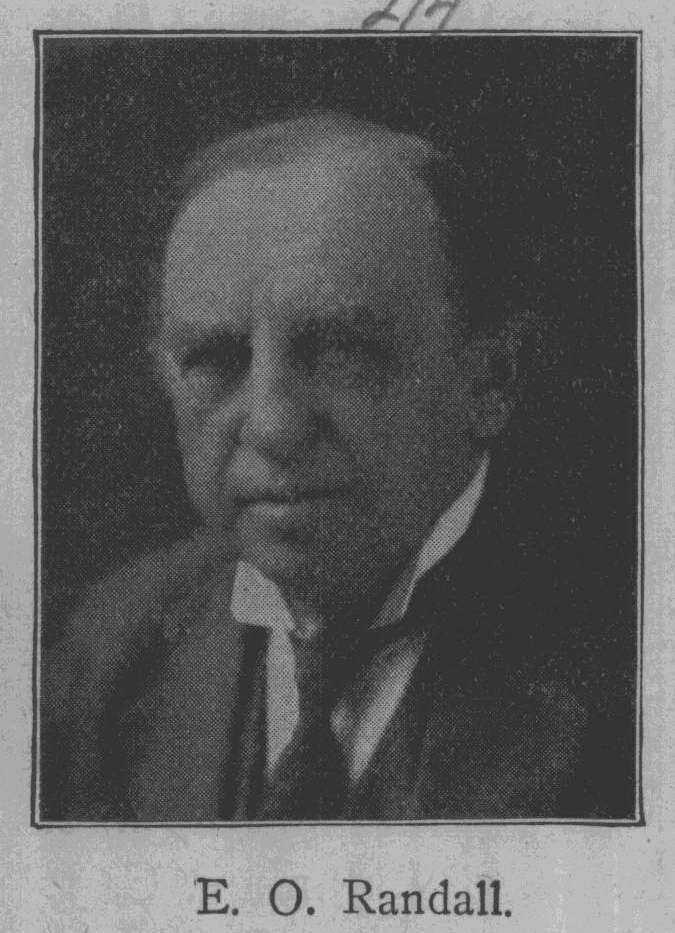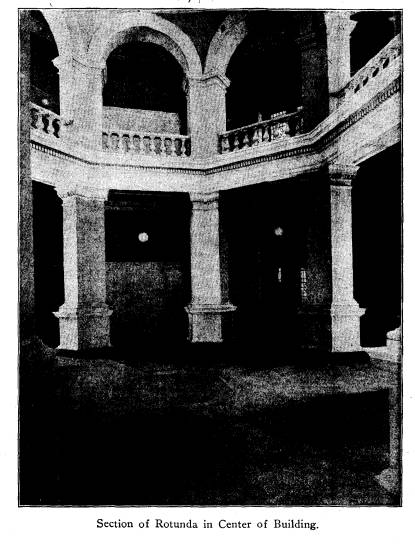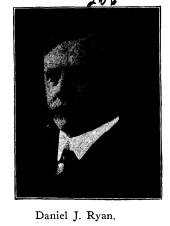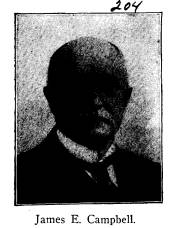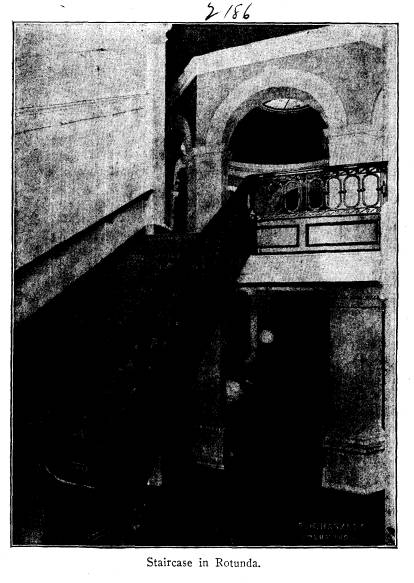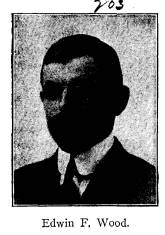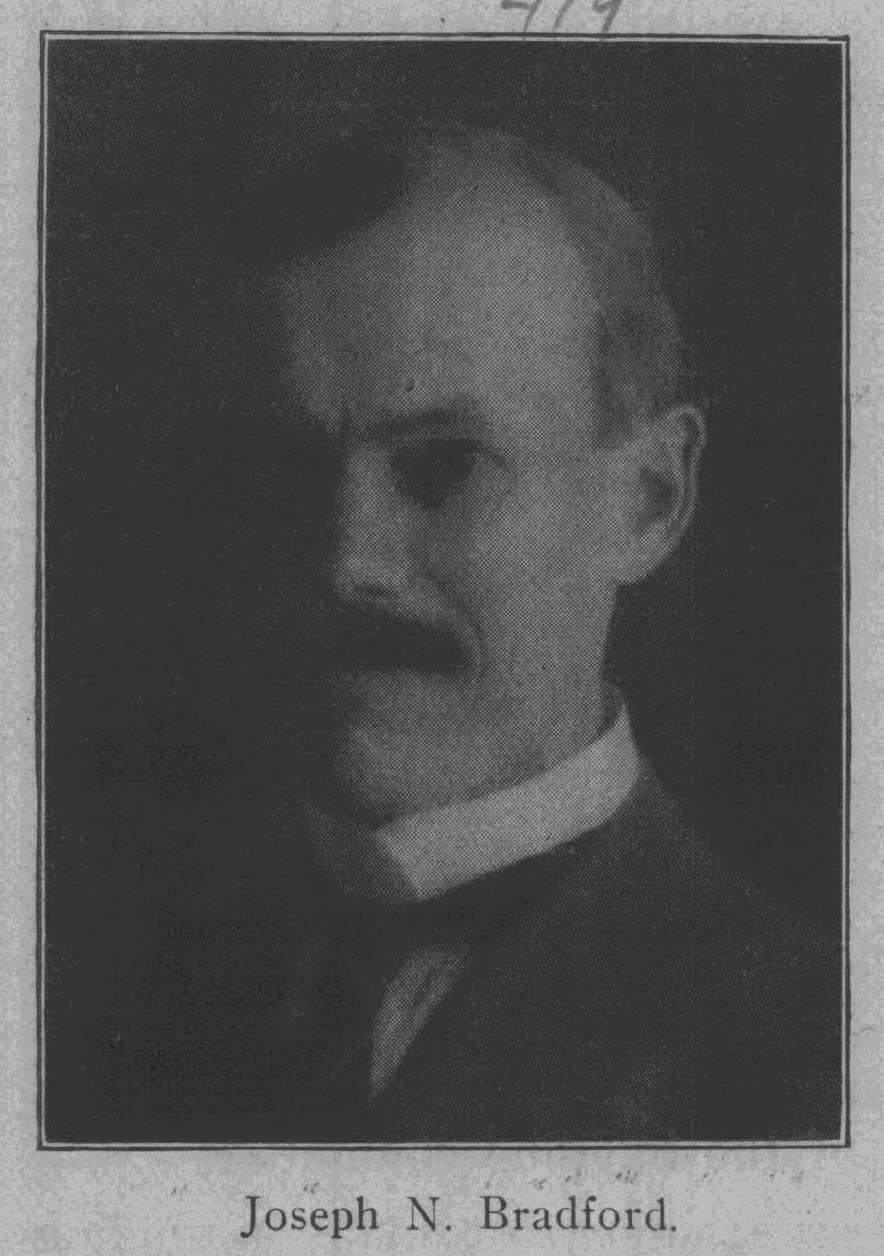Ohio History Journal
|
Dedicatory Exercises May 30, 1914. 339
who were following us in the retreating continental Ice Sheet in Ohio as the Eskimo are still doing in Alaska and Greenland. Thus geology and archaeology join hands in our state to shed light on the earliest conditions under which man struggled to maintain his existence in this world of thorns and thistles, of earthquakes and volcanoes, and of waxing and waning ice sheets. The contrast between those conditions and those in which we live is such as to make us pause and give thanks that our lines have fallen in such pleasant places and that we have so goodly an heritage. REMARKS OF SECRETARY RANDALL. Following President Wright's address, Mr. Randall, Secre- tary of the Society, spoke impromptu, giving, in brief, some of the main facts and incidents connected with the origin and |
|
|
|
the then approaching American Centennial Exposition to be held at Philadelphia in the year 1876. It was proposed by the new Ohio Society that an exhibit of Ohio Archaeology be made at the coming exhibition. In the prosecution of this purpose appear the names of R. B. Hayes, then governor, Dr. N. S. Townshend, professor O. S. U., Gen. R. Brinkerhoff, M. C. Read, distin- guished writer on Archaeology, John H. Klippert, State Geolo- gist, C. C. Baldwin and Charles Whittlesey, respectively president and secretary of Western Reserve Historical Society. These |
340 Ohio Arch. and Hist.
Society Publications.
gentlemen, prominent in the field of
scholarship and the study of
the archaeology and history of Ohio,
secured an appropriation
from the General Assembly of $2,500.00
for the purposes of an
Ohio exhibit at Philadelphia.
Collections of an archaeological
and historical nature were solicited
from all parts of the State
and the result, in the Centennial
Exposition, was that, outside of
the National Smithsonian Institution,
Ohio had the finest and
most interesting exhibit of prehistoric
antiquities and historic
relics.
Following this brilliant start, the Ohio
Archaeological Asso-
ciation struggled upon meagre means and
almost purely voluntary
efforts of its members, there being no
employed agent to properly
nurture its existence and growth. It
feebly lived until the un-
timely death (November 11, 1883)
of its Secretary and master
spirit, Professor Short. The society
became inoperative. But
the purpose of its members sprang anew.
Governor George
Hoadly, who took an active interest in
all matters pertaining to
the archaeology and history of the
state, upon his accession to
office, conferred with Mr. A. A. Graham,
author of the History
of Richland county, who had been a
participant in the affairs
of the Ohio Archaeological Association
and who was an en-
thusiastic student of Ohio Antiquities.
The revival of the old
society upon broadened lines was decided
upon. A meeting for
this purpose was called to convene at
the office of the Secretary
of State, on February 12, 1885. There
were present at this
meeting, General James S. Robinson, of
Kenton; Hon. Chauncey
N. Olds, of Columbus; Professor N. S.
Townshend and Samuel
C. Derby, of Ohio State University;
Messrs. J. J. Janney, C. J.
Wetmore and A. A. Graham, of Columbus.
General Robinson
was made chairman and Mr. Graham
secretary of the meeting.
The object of the gathering was stated
to be to consider not
only the revival and reorganization of
the former Archaeological
Society but in addition to develop and
emphasize an historical
side, which would largely increase the
value of the Society and
the scope of its labors.
As a result of this conference General
Robinson, Professor
Townshend and Mr. Graham were appointed
a committee to
Dedicatory Exercises May 30, 1914. 341
draft and issue a call for a state
convention of those interested
in the subject, to be held at Columbus,
March 12, 1885.
In pursuance of these instructions the
committee prepared
a circular which, at some length, stated
the object of the pro-
posed society, viz., that of securing
the membership and bring-
ing about the cooperation of students,
scholars and others inter-
ested in the archaeology and history of
our state, to explore
the earthworks of the prehistoric men,
to collect relics and speci-
mens found therein, to gather implements
of the Indian period,
secure and preserve manuscripts,
pamphlets, papers, books,
paintings and all other historical
material, provide rooms for
the proper preservation and arrangement
of an archaeological
museum and an historical library. This
circular was sent to
the leading newspapers of the state,
which gave it due publicity,
to the principal educators and school
teachers and to all persons
whom it was thought might be interested
therein. The responses
were prompt and evinced a degree of
interest in the movement
beyond the expectation of its promotors.
Pending the convention proposed,
informal meetings of its
protagonists were held in Columbus to
perfect arrangements.
At one of these Alexis Cope, John W.
Andrews and A. A.
Graham were appointed a committee to
draft a plan of perma-
nent organization. Richard S. Harrison,
Henry T. Chittenden
and Robert E. Neil were made a committee
on arrangements
and John J. Janney, Chas. J. Wetmore,
Sr., and Samuel S.
Rickly were delegated to select
temporary officers.
Pursuant to the "call" issued
for this convention, about
sixty gentlemen, representing all parts
of the state and all fields
of intellectual endeavor, met in the
state library on the morning
of Thursday, March 12, 1885. The
meeting was called to order
by Mr. Rickly, who nominated Allen G.
Thurman as chairman,
who, on taking the chair, gave a general
outline of the work
done by the former Archaeological
Association, and briefly
sketched the work proposed for the new
organization. Mr.
Graham
was elected temporary secretary of the convention.
The committee on permanent organization
reported articles of
incorporation, which, in substance,
were: The name of the
organization should be the Ohio State
Archaeological and His-
|
342 Ohio Arch. and Hist. Society Publications. |
|
|
Dedicatory Exercises May 30, 1914. 343
torical Society; its principal place of
business should be at the
city of Columbus; that it was formed for
the purpose of pro-
moting the knowledge of archaeology and
history of Ohio, by
establishing and maintaining a museum
and library, etc.; the
society should have no capital stock,
and in no way be organized
for profit. The articles of
incorporation were signed by the
charter members.
These articles of incorporation were
duly filed with the
Secretary of State on March 13, 1885,
which was the date of
the legal birth of the society.
The committee on organization reported a
constitution and
by-laws for the society. At the meeting
in the afternoon of
the same day the first board of trustees
was elected.
In the evening of March 12th, the first
public meeting of
the Society was held in the senate
chamber of the capitol, which
was well filled with members of the
legislature, prospective
members of the Society and the public
which had been invited.
Hon. Allen G. Thurman presided. General
R. Brinkerhoff
spoke on "The Old Ohio
Archaeological Association;" Dr.
Israel W. Andrews on "The Beginning
of the Colonial System
of the United States;" Prof. John
B. Peaslee on "Ohio;" Hon.
William P. Cutler (grandson of Dr.
Manasseh Cutler), on "The
Settlement of Ohio;" Hon. Henry B.
Curtis on "The Influence
of the Character of the Pioneers upon
the History of the State,"
and Dr. William E. Moore on "The
Religious History of the
State."
On the following day, March 13, the
Society met in the
state library, when the organization was
completed by the elec-
tion of the officers. [A complete list
of the officers and trustees
is given at the conclusion of the
account of these proceedings.]
It was at that time purposed that a vice
president be elected
from each of the twenty-one
congressional districts of the state,
and in furtherance of that proposition
vice presidents were
elected from a few of the districts. The
plan of district vice
presidents obtained only a year or two,
the plan being found
impracticable.
Between the dates of April 24, 1885, and
February 18, 1886,
the Society held public meetings in
Columbus, Hamilton and
344 Ohio Arch. and Hist.
Society Publications.
Mansfield, at which addresses were
delivered by distinguished
scholars and speakers. On the latter
date (February 18, 1886),
the Society held its second annual
meeting.* This meeting was
held in the State library, Capitol
building, Columbus. General
Brinkerhoff presided. An open meeting of
the Society was held
in the evening in the senate chamber,
when addresses were made
by the historian, Henry Howe, Prof. I.
W. Andrews and other
distinguished speakers.
At the third annual meeting of the
Society (February 23,
1887), it was resolved that the Society
issue a publication in
pamphlet or magazine form, not less than
once per quarter, and
this magazine, known as The Ohio State
Archaeological and
Historical Quarterly, first made its
appearance in the following
June (1887), under the direction of an
editorial committee con-
sisting of Prof. George W. Knight, Burke
A. Hinsdale, G.
Frederick Wright, William H. Venable and
Israel W. Andrews.
This Quarterly, under the auspices stated, was published
until three volumes were completed, the last in 1891, when
the
publication was discontinued for lack of funds and engross-
ment of the efforts of the
Society in other directions. Its
publication was resumed in 1894, under
the editorial direction
of Mr. E. O. Randall, at that time Associate Secretary, and who
became a member of the Society in 1885. The twenty-third
volume is now (May 30, 1914) in process
of publication under
the same editorial direction.
The year 1888 was one of intense
activity of the Society.
That year, under its direction, was held
at Marietta the Cen-
tennial Celebration of the Northwest
Territory, during the 5th
and 6th days of April.+ At this
celebration, under the manage-
ment of the Society, some of the most
distinguished statesmen
and scholars of the country
participated, viz., Gen. R. B. Hayes;
Hon. George F. Hoar; Hon. George B.
Loring; Gov. J. B. For-
aker; Ex-Gov. Joseph Cox; Hon. William
M. Farrar; William
Henry Smith; J. Randolph Tucker, of
Virginia; Hon. Samuel F.
*This meeting in the records of the
annual publications of the
Society is mistakenly designated as the
first annual meeting.
+Detailed account of the Marietta
Centennial will be found in
volume 2 of the Society publications.
Dedicatory Exercises May 30, 1914. 345
Hunt; Rev. Edward E. Hale; Dr. A. L.
Chapin; Dr. Henry M.
Storrs; Hon. John W. Daniel, of
Virginia.
In the fall of this year (1888) the
Society, by invitation of
the State authorities, cooperated with a
state committee ap-
pointed by the legislature, in a program
of several days' duration,
commemorating the one hundredth
anniversary of the settlement
of the Northwest Territory. This
celebration was held at Co-
lumbus, and at the same time and place
the Grand Army of
the Republic held its National
Encampment.
The fifth annual meeting consisted of
two days' session,
held January 31 and February 1,
1889, the first day's meeting
being held in the senate chamber at
Columbus, and the second
days's proceedings in Chillicothe, where
a banquet was tendered
the members of the society by citizens
of the first capital of
Ohio, and an historical address was
delivered by Henry Howe.
In the winter of 1888 and 1889, through
the courtesy of
Adjutant General H. A. Axline, the
society was given space
for its museum and library in a room on
the third floor, east
side, of the State House, where the
books and relics were
arranged, as well as possible, in
shelves and cases. Up to this
time the office of the Secretary, Mr.
Graham, consisted merely
of desk room in one of the alcoves of
the state library.
On the days of October 16, 17, 18 and
19, 1890, under
the auspices and management of the Society,
there was held
at the city of Gallipolis a centennial
anniversary celebration of
the French settlement of that town in
the year 1790. The event,
most successfully carried out through
the aid of the people of
Gallipolis, attracted attention of the
press throughout the
country. Distinguished speakers were
present from other states,
and historical addresses were delivered
by James E. Campbell,
Governor of Ohio, Judge R. A. Safford,
Gen. Charles H.
Grosvenor, Rev. Washington Gladden,
Daniel J. Ryan, Rev.
J. M. Davis (President, Rio Grande
College), Rev. H. A.
Thompson (President, Otterbein
University), Col. R. D. Mar-
shall, Rev. David Moor (Editor, The
Western Christian Advo-
cate), Rev. Dr. Lasher (Editor, Journal
and Messenger), Rev.
Sylvester Scoville (President, Wooster
College), Bishop Wat-
|
346 Ohio Arch. and Hist. Society Publications. terson of the Roman Catholic Church, and others. A temporary museum was improvised, in which was exhibited a large collec- tion of historical relics. |
|
|
|
effecting the semi-official state control of the Society. That reso- lution was as follows: "Be it resolved by the General Assembly of the State of Ohio, That the Governor is hereby authorized to appoint as members of the board of trustees of the Ohio Archaeological and Historical Society, six (6) persons to serve without compensation as follows: Two for the term of one year, two for the term of two years, and two for the term of three years, from the 9th day of February, 1891, and annually thereafter to appoint two persons on said board for the term of three years, but said appointments shall not bind the state to make annual appropriations for said society." (Adopted April 16, 1891.) This plan, whereby the Governor was to appoint a num- ber of the trustees, was intended to avoid the objection that the state in appropriating funds to the Society had no over- sight or control as to its expenditures. From this date the society elected fifteen trustees, five each year to serve for three years, respectively, while the Governor appointed six, two each year to serve three years respectively. Under this resolution Governor Campbell appointed to serve three years (until 1894) Charles P. Griffin, Andrew Robeson; for two years (until 1893) |
Dedicatory Exercises May 30, 1914. 347
Israel Williams and E. P. Lockwood; for
one year (until 1892)
Matthew C. Read and William J. Gilmore.
This same legislature also passed a
joint resolution as to
the custodianship of Fort Ancient, as
follows:
"Resolved by the General
Assembly of the State of Ohio, That
the care and control of Fort Ancient,
shall be vested in the board of
trustees of the Ohio Archaeological and
Historical Society, who shall hold
the lands and property thereon subject
to such use as the General
Assembly may by law direct."
(Adopted April 24, 1891.)
On October 20th, 1892, a special meeting
of the society was
held, as the result of an excursion for
that purpose, at the Mc-
Coy House, Chicago, Ill. At this meeting
Ex-President Ruther-
for B. Hayes was elected a trustee and
president, to fill the
unexpired term of Mr. Francis C.
Sessions, who died March
25th, 1892, and who was at the time of
his death both trustee
and president.
There was no ninth (eighth according to
old reckoning)
annual meeting of the society held in
1893, as there should
have been in February of that year, the
purpose having been
to hold this annual meeting at Chicago,
but when that was sub-
sequently attempted the question arose
as to the legality of the
society holding such meeting without the
state of Ohio, and
no meeting was held, the trustees
holding over, pending the
election of the successors of those
whose terms expired at this
meeting.
The society made an extensive exhibit of
archaeological and
historical material at the Chicago
Columbian Exposition, which
was one of the distinguishing features
of the exposition, attract-
ing wide attention and eliciting
complimentary articles in the
newspapers throughout the country.
Daniel J. Ryan was pres-
ident of the Ohio Commission for the
Exposition, and A. A.
Graham was supervisor of the Society's
exhibit.
The trustees, however, held a meeting in
the state library,
Columbus, April 23, 1893. At this
meeting, on account of ill
health, Secretary Graham was granted
indefinite leave of
absence, and Mr. E. O. Randall was
chosen associate secretary.
The Governor (McKinley), made the usual
appointment of two
348 Ohio Arch. and Hist.
Society Publications.
trustees, viz., E. O. Randall* and
Josiah Hartzell, to succeed the
retiring trustees, Messrs. Read and
Lockwood. These gentle-
men were appointed to serve from
February 19, 1893, to Febru-
ary 19, 1896. On February 28, 1894, Mr.
Hartzell resigned and
Mr. A. H. Smythe was appointed by the
Governor to fill out the
unexpired term.
At the tenth annual meeting of the
society, held February
19, 1894, Mr. Randall was chosen
temporary secretary and the
society accepted the possession of
Serpent Mound, in Adams
county, it being presented through the
instrumentality of Prof.
Frederick Putnam to the Society by the
trustees of Harvard
University. At this meeting, also, Mr.
Warren K. Moorehead,
who had been chosen by the Ohio State
University to take
charge of their department of
archaeology in Orton Hall, was
also made Curator of the Society's
archaeological museum, and
director of its archaeological
explorations.
Mr. A. A. Graham tendered his
resignation as secretary of
the Society on November 10th, 1894, at
which time Mr. Ran-
dall was elected secretary to succeed
him; this office of secretary-
ship Mr. Randall has held to the present
time.
In August, 1895, the society
participated in the proceedings
of the Greenville Centennial
Celebration, the one hundredth
anniversary of the signing of the
Greenville Treaty.
On April 3, 1897, Mr. Warren K.
Moorehead tendered
his resignation as Curator of the
Society, which resignation
was accepted August 27th, and
Mr. Clarence Loveberry, who
had been acting as assistant curator,
was promoted to the
Curatorship.
On September 29, 1898, the Society
participated in the Cen-
tennial Anniversary of the settlement of
Gnadenhutten by John
Heckewelder and the Moravian Mission.
This celebration was
inspired and directed by the Rev.
William C. Rice.
On June 1, 1898, William C. Mills was elected by the
executive committee as Curator, to serve
until February 1, 1899,
* Mr. Randall was subsequently
reappointed as trustee suc-
cessively by Governors Bushnell, Nash,
Herrick, Harris, Harmon and
Cox, being an uninterrupted service from
his first appointment to the
present time, a period of twenty-one
years.
|
Dedicatory Exercises May 30, 1914. 349 at which time, at the annual meeting of the society, he was made Curator, which office he has continued to fill, with distinguished service, by successive elections, until the present time. In the summer of 1899, the American Society for the Ad- vancement of Science, held its national convention at Columbus, under the partial auspices of the Ohio State Archaeological and Historical Society, which made an excursion to Fort Ancient, with delegates of the Science association as its guests. In the summer of 1901 the Society, under provisions by the General Assembly, made an archaeological exhibit at the Pan American Exposition, held at Buffalo. The exhibit was under |
|
|
|
tennial celebration: J. Warren Keifer, Rush R. Sloane, James Barnett, David S. Gray, Charles M. Anderson, and Robert W. Manly. Mr. Randall was chosen secretary of the Cen- tennial Commission. On May 20th and 21st, 1903, under the immediate direction of the Society, there was held at Chillicothe a centennial celebration of the admission of Ohio as a state. It was the most important and interesting historical event in the history of the state. The proceedings are set forth in detail in a separate volume, consisting of some 700 pages, edited by Sec- retary Randall. During the summer of 1903 the Society made an exhibit at the Louisiana Purchase Exposition at St. Louis, under the supervision of Curator Mills. |
350
Ohio Arch. and Hist. Society Publications.
Preliminary to the centennial ceremonies
to be held in 1903,
under the auspices of the Society, on
November 29, 1902, at
Chillicothe, an interesting event
occurred in the nature of the
unveiling of the tablet in the court
house, the tablet being a bar
relief of Ohio's first Governor, Edwin
Tiffin. The tablet was
presented for this purpose by Mr.
William H. Hunter, one of
the trustees of the Society and thorough
scholar and extensive
writer of early Ohio history. There were
many distinguished
visitors present, the main address being
delivered by Daniel J.
Ryan, other speakers being Robert W.
Manly, Mayor W. D.
Yaple, Judge J. C. Douglas and William
T. McClintock.
On September 30, 1905, the Society
held public exercises at
the site of Big Bottom Park, on the
Muskingum river; the loca-
tion of the historic pioneer stockade
which the Indians burned in
1791, massacring nearly all the inmates.
This sacred ground,
marked by a fine commemorative marble
monument, was pre-
sented to the Society by Mr. Obediah
Brokow. The celebration
of the acceptance by the Society was
attended by several thou-
sand spectators. Addresses were made by
C. L. Martzolff, Tod
B. Galloway, D. J. Ryan, R. Brinkerhoff,
E. O. Randall and G.
F. Wright. James Ball Naylor read a poem
written for the
occasion.
In the summer of 1907 the Society
again exhibited a portion
of its museum at the Jamestown
Exposition, which exhibit, like
its other archaeological exhibits, was a
center of attraction,
especially among visitors from Ohio, and
added much to the
fame of the Society because of its work
along archaeological
lines. This exhibit was also under the
excellent supervision of
Curator Mills.
For many years Col. Webb C. Hayes had in
contemplation
the preservation of Spiegel Grove,
splendid home of his dis-
tinguished father, as a memorial to one
of Ohio's great presi-
dents. He wished that this might become
the Mt. Vernon of
the Buckeye State, and finally selected
our Society as the proper
agent for the carrying out of this loyal
idea. After conferences
with the trustees and proper agreements
as to plans therefor,
on March 31, 1909, Col. Hayes
delivered to the Society his
|
Dedicatory Exercises May 30, 1914. 351 |
|
|
352 Ohio Arch. and Hist.
Society Publications.
deed for 10.77 acres, known
as the "Harrison Trail," through
Spiegel Grove, Fremont.
On March 10th, 1910, Colonel Hayes
presented to the
Society, through deed of that date, ten
acres, more or less, being
the remaining portion of Spiegel Grove
property, excepting some
five acres embracing the residence.
At the time of the delivery of the
second deed, Colonel Hayes
also placed in escrow a third deed, to
the Society, covering the
remaining five acres, including the
homestead, the complete de-
livery of the latter deed being
conditioned on certain homestead
reservations and upon the agreement that
the Society, within a
certain specified time, would erect, on
the ground to be trans-
ferred, a fireproof building for the
permanent housing of the
library and historical documents of the
late President R. B.
Hayes.
The conditions of these deeds have
nearly been complied
with by the completion of a beautiful
memorial library and
museum building, which was provided for
by appropriation by
the General Assembly in the session of 1911.
The dedication of this building is but a
few weeks off, and
at that time the history of the transfer
of Spiegel Grove to our
Society and the erection of an
appropriate museum and library
building will be related and proper
credit given to the patriotic
generosity and filial devotion of
Colonel Hayes.
July 17, 1912, the executive committee,
having previously
been authorized so to do, accepted the
property known as Logan
Elm Park, from the Pickaway Historical
Association. The
donation of this park to the Society was
made possible by the
active efforts of Mrs. Dr: Howard Jones
and the liberality of
Miss Elizabeth Ruggles, who donated the
funds with which
the Pickaway County Historical Society
obtained the title which
it transferred to our Society.
On October 2nd, 1912, the State Society
dedicated the
Logan Elm, carrying out a program that
was most unique and
interesting. It happened to be at the
time of the meeting at
Columbus of the National Association of
American Indians,
many of whom were the guests of the
State Society and who pro-
ceeded to Logan Elm Park and
participates in the exercises.
Dedicatory Exercises May 30, 1914. 353
Addresses were made by Mrs. Howard
Jones, Frank Tallmadge,
G. Frederick Wright, Chase Stewart,
Curator Mills, Secretary
Randall and by Charles E. Dagenett of
the Peoria tribe of Indians
and Fred E. Parker of one of the
Iroquois tribes. Several
Indians representing the Sioux,
Chippewa, Winnebago, Seneca,
Mingo, Osage, Cherokee, Cheyenne, and
other tribes were present,
and all spoke with much feeling and
praise concerning the great
Mingo chief Logan, whose speech was
supposed to have been
delivered-at least read by Captain
Gibson to Dunsmore's army-
on the very spot where the present
speakers were holding the
dedicatory exercises. Miss Calvert of
the Sioux tribe, South
Dakota, read Logan's speech.
Such, in brief, is a running chronicle
of the more important
events in the history of the Society to
the present time. All
these incidents mentioned have been
fully related in the annual
or special publications of the Society.
That this history, alluded
to in so desultory a way, represents the
expenditure of great
labor and patience on the part of the
officers goes without say-
ing. Like all achievements of human
effort, the growth of
this Society from its beginning to its
splendid accomplishment
to-day is the story of patience and
struggle. At times we have
met with obstacles and opposition from
without, chiefly from
the fact that the popular idea had
prevailed in some quarters
that the purpose and workings of this
Society were sentimental
and ideal rather than practical and
utilitarian-in short, that
it is a luxury for the enjoyment of
faddists, archaeological
cranks and historical enthusiasts. The
greatest work which our
Society has accomplished, to my mind,
has been the education
in archaeology and history it has
brought about in the State of
Ohio; that such an institution not only
has a purpose but that
that purpose has been worth while and is
one of the most im-
portant features of public education,
namely, the inculcation in
the youth of a knowledge of the past, a
study of history. To
know archaeology and history is to know
the human race, and
to know the human race is no small
acquisition. The Society
has had its critics, indeed its enemies,
but that was to be expected.
It is the lot of every successful
effort.
Vol. XXIII -23.
|
354 Ohio Arch. and Hist. Society Publications. The chief aims of the Society have been: the research in archaeological lines, particularly concerning that mysterious people known as the "Mound Builders," in the relics of whom this state is richer than any other state in the Union; to preserve these relics and learn as much as possible about the people who created them; to gather, preserve and make public the historical data of the state. We have not succeeded, possibly, as have the societies of some other states in the gathering of original material, for two reasons. Such material had been greatly scattered or destroyed before our Society came into existence, and one other society, that of Wisconsin, was in the field be- fore us and for years literally scoured the state for manuscripts |
|
|
|
We have, however, performed a great and lasting work in disseminating the material that we have collected and preserved, in popular publications which, through the liberal provisions of the General Assembly, have been widely placed with the libraries, newspapers and parties especially interested in such work. I have received many testimonials, among them those from the professors of American history both at Harvard and Yale, saying that no state society has done so much to disseminate, among the schools and students, the history of its state, as has our Society. We feel, therefore, that we have, in no small measure, "made good" in our efforts, and that the state has |
Dedicatory Exercises May 30,
1914. 355
been thoroughly justified in giving us
the financial aid which
it has done. The Society is certainly
upon a most substantial
basis for it now possesses or has the
control and custodianship
of property aggregating nearly half a
million dollars in value.
It would be quite impossible, owing to
lack of time, for
me to give due credit to the many
gentlemen for whose assist-
ance we are indebted. First of all,
great credit should be given
to the building committee, and
particularly to its chairman, Mr.
Lewis P. Schaus, than whom it would be
difficult to find a man
better qualified for that position, as
he has had much experience
in the erection of public buildings. He
has devoted a large part
of his time for the past two years to
the Society, without any re-
ward save that of the interest he has
taken in the work, being
in hearty sympathy with its purpose and
accomplishments. The
other members of the committee have
rallied to the support of the
chairman with unusual harmony and
enthusiasm. Nor should
we omit to mention the services of our
treasurer, Mr. Edwin
F. Wood, whose responsibility has been
to oversee the financial
accountings and make the proper
adjustments between the state
and the Society.
The architect, Joseph N. Bradford,
professor in the architec-
tural department of the University, has
acquitted himself with
distinct honor. It was a fortunate
stroke for the Society when
it secured his services. His labors
speak for themselves in
the efficient and successful manner in
which he carried out the
general ideas and suggestions of the
building committee.
Moreover we have been exceedingly
fortunate in finding
friends when and where most needed.
Almost from the beginning of my
secretaryship, in addi-
tion to my yearly duty of presenting to
the finance committees
of the legislature the needs of our
Society, my efforts were
directed toward securing an
appropriation for this building.
Time and again I appeared before the
finance committees of
the Legislature and plead, with all the
persuasion within me,
that the state give us a local
habitation and a home. Bills were
introduced either separately or in
conjunction with the general
appropriations, having a building in
view. But all in vain.
Finally the psychological moment came,
when the Finance Com-
|
356 Ohio Arch. and Hist. Society Publications. mittee of the House of the 79th General Assembly, of which committee Mr. Harry L. Goodbread was chairman, gave us fa- vorable hearing, and the item of fifty thousand dollars each year for the years 1911 and 1912 was inserted in the general appro- priation bill. Governor Judson Harmon, who was one of our interested and appreciative members, gave the project his ap- proval - without which the passage of the item would have been in vain- and the finance committee of the Senate, of which Mr. |
|
|
|
Those of you who have visited St. Paul's Cathedral in London, will recall that there is no statue or tablet to the mem- ory of its great architect, Sir Christopher Wren, but in the base- ment, in an almost obscure corner, set in the stone floor, is a small bronze plate, upon which is engraved the name of the architect, beneath which are the words "Si monumentum quaeris, circumspice," which translated reads "If you ask for my monu- ment, look about you." And so I would say, ladies and gentle- men, as to the present officers of the Archaeological and His- torical Society, if you ask for their monument, look about you. |
